Graphene Oxide Membrane: Synthesis, Properties, and Applications
VerifiedAdded on 2019/10/31
|36
|10599
|421
Report
AI Summary
This report delves into the realm of graphene oxide (GO) membranes, exploring their significance in water desalination and related applications. It begins with an introduction to GO membranes, emphasizing their use in freestanding membranes, surface modification, and composite layers. The report details the materials and methods involved, including GO synthesis via the modified Hummers method, vacuum filtration, and the properties of reduced graphene oxide (rGO) membranes. Characterization techniques such as AFM, SEM, and Raman spectroscopy are discussed to analyze the GO flakes. Furthermore, the report examines permeation experiments using the forward osmosis (FO) process, illustrating how GO membranes are employed in this context. The report concludes with a summary of findings and references to relevant research.
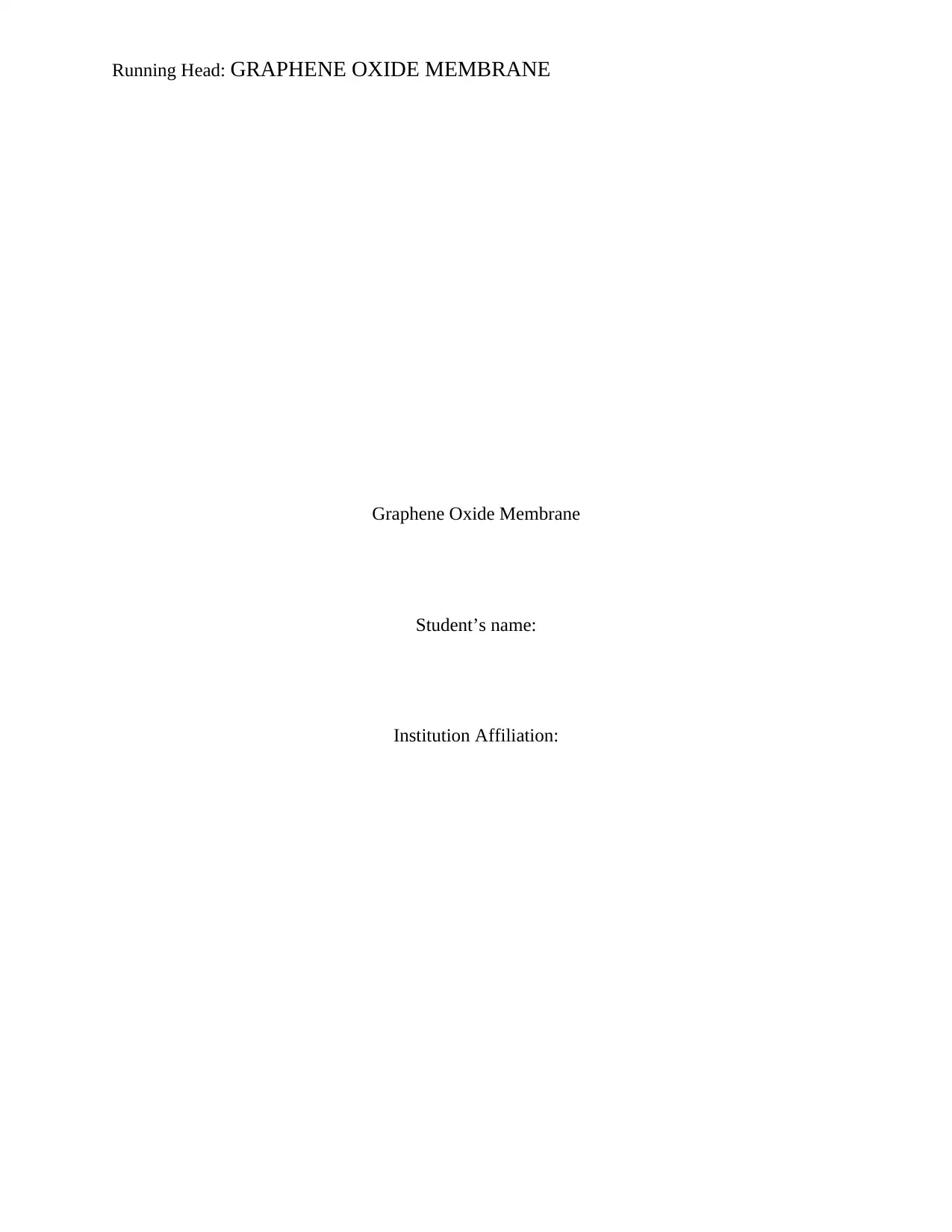
Running Head: GRAPHENE OXIDE MEMBRANE
Graphene Oxide Membrane
Student’s name:
Institution Affiliation:
Graphene Oxide Membrane
Student’s name:
Institution Affiliation:
Paraphrase This Document
Need a fresh take? Get an instant paraphrase of this document with our AI Paraphraser
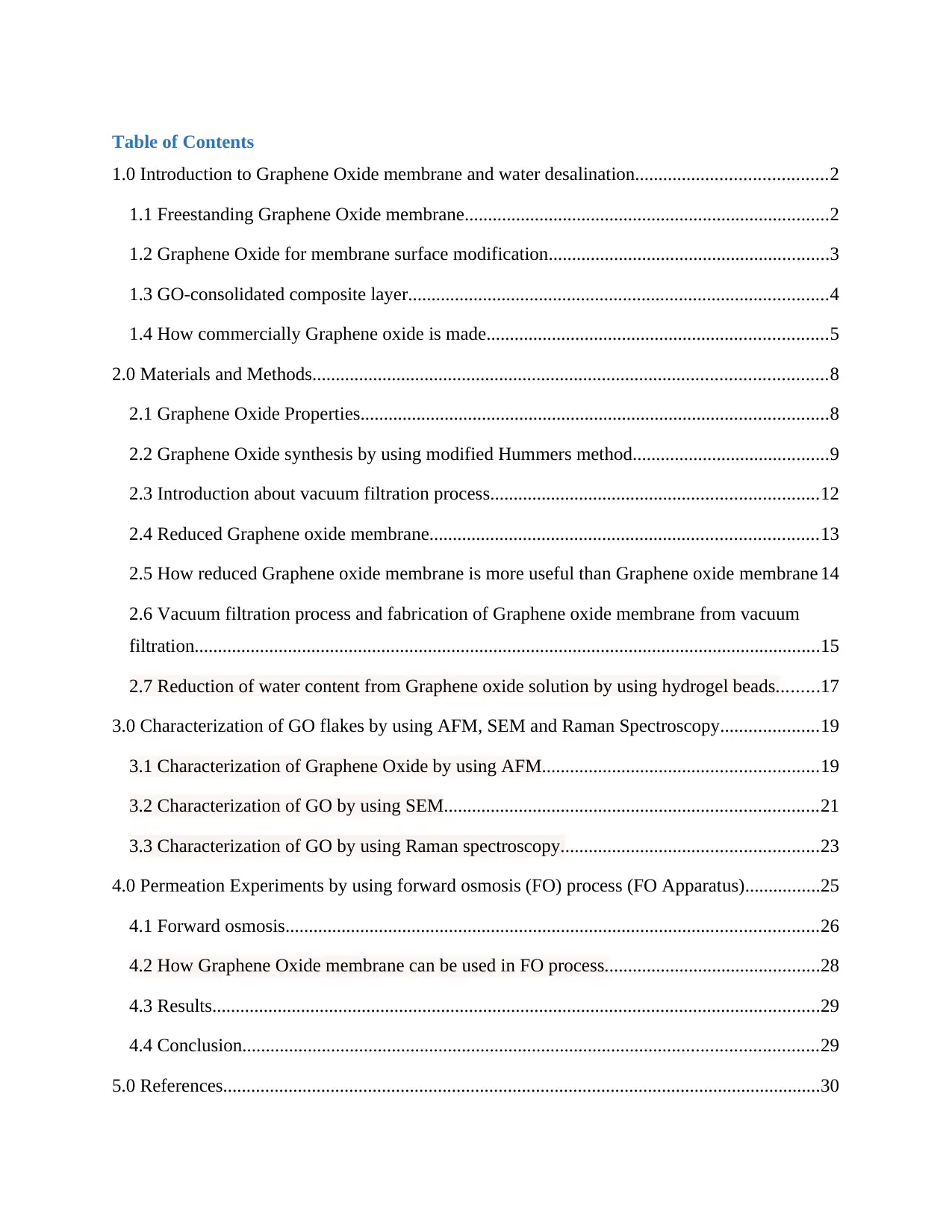
Table of Contents
1.0 Introduction to Graphene Oxide membrane and water desalination.........................................2
1.1 Freestanding Graphene Oxide membrane..............................................................................2
1.2 Graphene Oxide for membrane surface modification............................................................3
1.3 GO-consolidated composite layer..........................................................................................4
1.4 How commercially Graphene oxide is made.........................................................................5
2.0 Materials and Methods..............................................................................................................8
2.1 Graphene Oxide Properties....................................................................................................8
2.2 Graphene Oxide synthesis by using modified Hummers method..........................................9
2.3 Introduction about vacuum filtration process......................................................................12
2.4 Reduced Graphene oxide membrane...................................................................................13
2.5 How reduced Graphene oxide membrane is more useful than Graphene oxide membrane 14
2.6 Vacuum filtration process and fabrication of Graphene oxide membrane from vacuum
filtration......................................................................................................................................15
2.7 Reduction of water content from Graphene oxide solution by using hydrogel beads.........17
3.0 Characterization of GO flakes by using AFM, SEM and Raman Spectroscopy.....................19
3.1 Characterization of Graphene Oxide by using AFM...........................................................19
3.2 Characterization of GO by using SEM................................................................................21
3.3 Characterization of GO by using Raman spectroscopy.......................................................23
4.0 Permeation Experiments by using forward osmosis (FO) process (FO Apparatus)................25
4.1 Forward osmosis..................................................................................................................26
4.2 How Graphene Oxide membrane can be used in FO process..............................................28
4.3 Results..................................................................................................................................29
4.4 Conclusion...........................................................................................................................29
5.0 References................................................................................................................................30
1.0 Introduction to Graphene Oxide membrane and water desalination.........................................2
1.1 Freestanding Graphene Oxide membrane..............................................................................2
1.2 Graphene Oxide for membrane surface modification............................................................3
1.3 GO-consolidated composite layer..........................................................................................4
1.4 How commercially Graphene oxide is made.........................................................................5
2.0 Materials and Methods..............................................................................................................8
2.1 Graphene Oxide Properties....................................................................................................8
2.2 Graphene Oxide synthesis by using modified Hummers method..........................................9
2.3 Introduction about vacuum filtration process......................................................................12
2.4 Reduced Graphene oxide membrane...................................................................................13
2.5 How reduced Graphene oxide membrane is more useful than Graphene oxide membrane 14
2.6 Vacuum filtration process and fabrication of Graphene oxide membrane from vacuum
filtration......................................................................................................................................15
2.7 Reduction of water content from Graphene oxide solution by using hydrogel beads.........17
3.0 Characterization of GO flakes by using AFM, SEM and Raman Spectroscopy.....................19
3.1 Characterization of Graphene Oxide by using AFM...........................................................19
3.2 Characterization of GO by using SEM................................................................................21
3.3 Characterization of GO by using Raman spectroscopy.......................................................23
4.0 Permeation Experiments by using forward osmosis (FO) process (FO Apparatus)................25
4.1 Forward osmosis..................................................................................................................26
4.2 How Graphene Oxide membrane can be used in FO process..............................................28
4.3 Results..................................................................................................................................29
4.4 Conclusion...........................................................................................................................29
5.0 References................................................................................................................................30
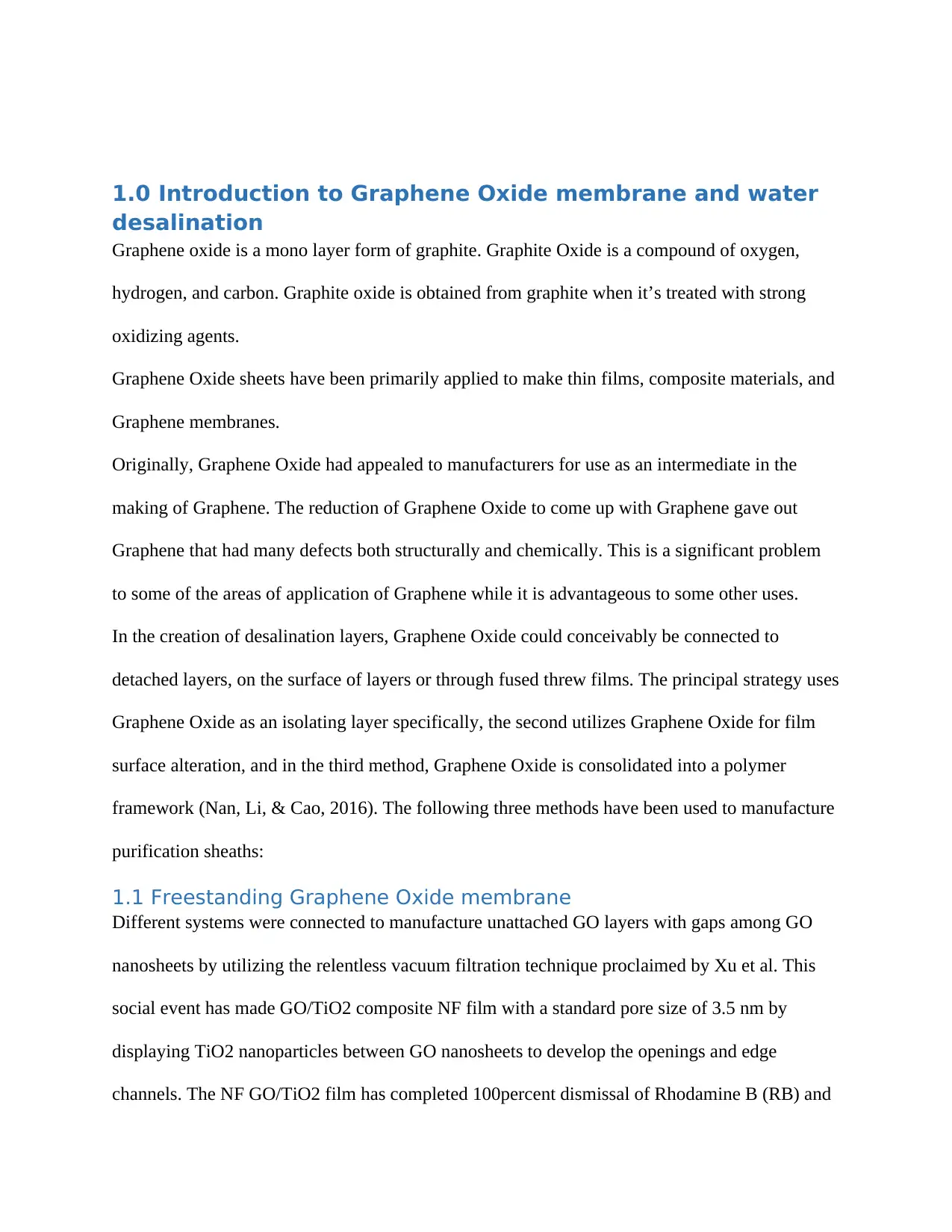
1.0 Introduction to Graphene Oxide membrane and water
desalination
Graphene oxide is a mono layer form of graphite. Graphite Oxide is a compound of oxygen,
hydrogen, and carbon. Graphite oxide is obtained from graphite when it’s treated with strong
oxidizing agents.
Graphene Oxide sheets have been primarily applied to make thin films, composite materials, and
Graphene membranes.
Originally, Graphene Oxide had appealed to manufacturers for use as an intermediate in the
making of Graphene. The reduction of Graphene Oxide to come up with Graphene gave out
Graphene that had many defects both structurally and chemically. This is a significant problem
to some of the areas of application of Graphene while it is advantageous to some other uses.
In the creation of desalination layers, Graphene Oxide could conceivably be connected to
detached layers, on the surface of layers or through fused threw films. The principal strategy uses
Graphene Oxide as an isolating layer specifically, the second utilizes Graphene Oxide for film
surface alteration, and in the third method, Graphene Oxide is consolidated into a polymer
framework (Nan, Li, & Cao, 2016). The following three methods have been used to manufacture
purification sheaths:
1.1 Freestanding Graphene Oxide membrane
Different systems were connected to manufacture unattached GO layers with gaps among GO
nanosheets by utilizing the relentless vacuum filtration technique proclaimed by Xu et al. This
social event has made GO/TiO2 composite NF film with a standard pore size of 3.5 nm by
displaying TiO2 nanoparticles between GO nanosheets to develop the openings and edge
channels. The NF GO/TiO2 film has completed 100percent dismissal of Rhodamine B (RB) and
desalination
Graphene oxide is a mono layer form of graphite. Graphite Oxide is a compound of oxygen,
hydrogen, and carbon. Graphite oxide is obtained from graphite when it’s treated with strong
oxidizing agents.
Graphene Oxide sheets have been primarily applied to make thin films, composite materials, and
Graphene membranes.
Originally, Graphene Oxide had appealed to manufacturers for use as an intermediate in the
making of Graphene. The reduction of Graphene Oxide to come up with Graphene gave out
Graphene that had many defects both structurally and chemically. This is a significant problem
to some of the areas of application of Graphene while it is advantageous to some other uses.
In the creation of desalination layers, Graphene Oxide could conceivably be connected to
detached layers, on the surface of layers or through fused threw films. The principal strategy uses
Graphene Oxide as an isolating layer specifically, the second utilizes Graphene Oxide for film
surface alteration, and in the third method, Graphene Oxide is consolidated into a polymer
framework (Nan, Li, & Cao, 2016). The following three methods have been used to manufacture
purification sheaths:
1.1 Freestanding Graphene Oxide membrane
Different systems were connected to manufacture unattached GO layers with gaps among GO
nanosheets by utilizing the relentless vacuum filtration technique proclaimed by Xu et al. This
social event has made GO/TiO2 composite NF film with a standard pore size of 3.5 nm by
displaying TiO2 nanoparticles between GO nanosheets to develop the openings and edge
channels. The NF GO/TiO2 film has completed 100percent dismissal of Rhodamine B (RB) and
⊘ This is a preview!⊘
Do you want full access?
Subscribe today to unlock all pages.

Trusted by 1+ million students worldwide
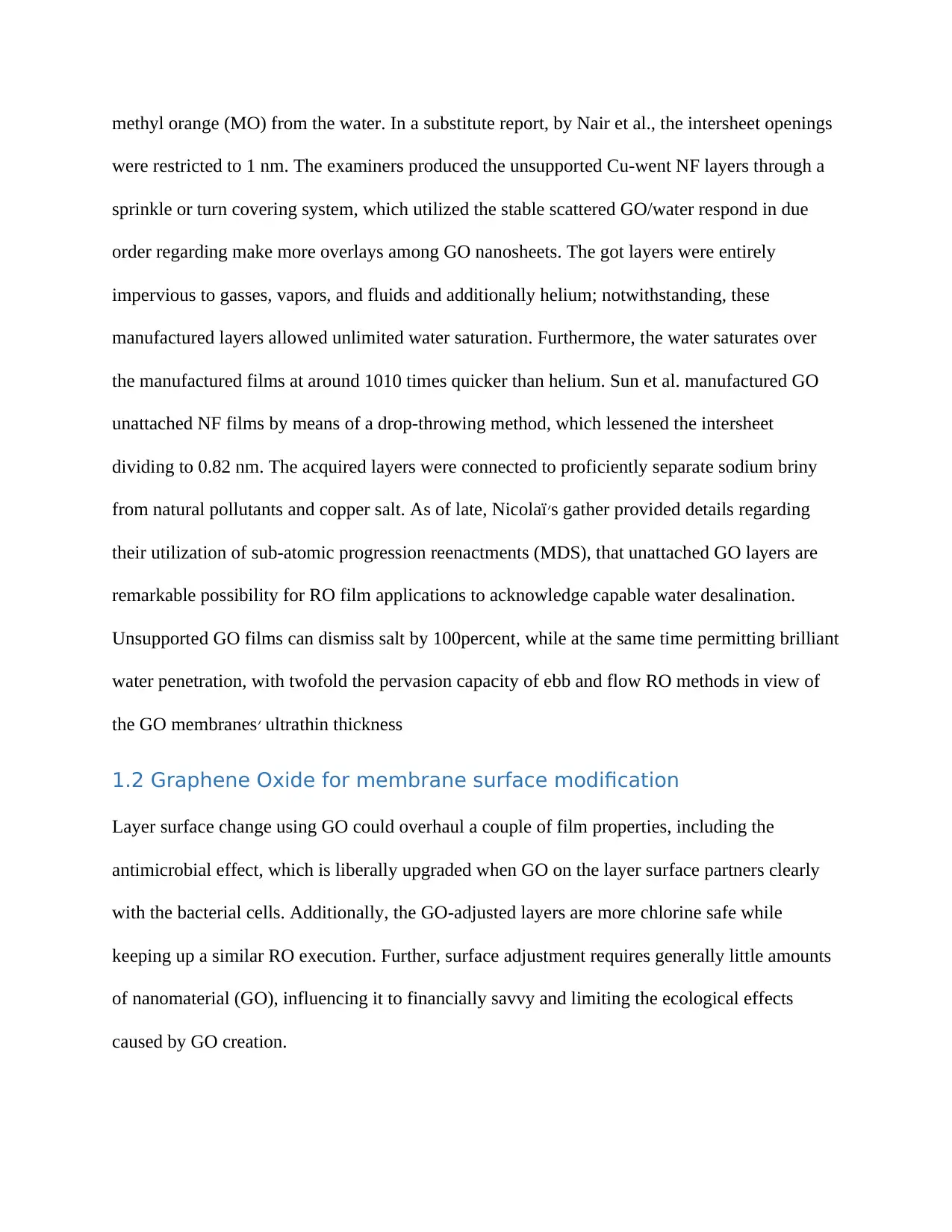
methyl orange (MO) from the water. In a substitute report, by Nair et al., the intersheet openings
were restricted to 1 nm. The examiners produced the unsupported Cu-went NF layers through a
sprinkle or turn covering system, which utilized the stable scattered GO/water respond in due
order regarding make more overlays among GO nanosheets. The got layers were entirely
impervious to gasses, vapors, and fluids and additionally helium; notwithstanding, these
manufactured layers allowed unlimited water saturation. Furthermore, the water saturates over
the manufactured films at around 1010 times quicker than helium. Sun et al. manufactured GO
unattached NF films by means of a drop-throwing method, which lessened the intersheet
dividing to 0.82 nm. The acquired layers were connected to proficiently separate sodium briny
from natural pollutants and copper salt. As of late, Nicolaï׳s gather provided details regarding
their utilization of sub-atomic progression reenactments (MDS), that unattached GO layers are
remarkable possibility for RO film applications to acknowledge capable water desalination.
Unsupported GO films can dismiss salt by 100percent, while at the same time permitting brilliant
water penetration, with twofold the pervasion capacity of ebb and flow RO methods in view of
the GO membranes׳ ultrathin thickness
1.2 Graphene Oxide for membrane surface modification
Layer surface change using GO could overhaul a couple of film properties, including the
antimicrobial effect, which is liberally upgraded when GO on the layer surface partners clearly
with the bacterial cells. Additionally, the GO-adjusted layers are more chlorine safe while
keeping up a similar RO execution. Further, surface adjustment requires generally little amounts
of nanomaterial (GO), influencing it to financially savvy and limiting the ecological effects
caused by GO creation.
were restricted to 1 nm. The examiners produced the unsupported Cu-went NF layers through a
sprinkle or turn covering system, which utilized the stable scattered GO/water respond in due
order regarding make more overlays among GO nanosheets. The got layers were entirely
impervious to gasses, vapors, and fluids and additionally helium; notwithstanding, these
manufactured layers allowed unlimited water saturation. Furthermore, the water saturates over
the manufactured films at around 1010 times quicker than helium. Sun et al. manufactured GO
unattached NF films by means of a drop-throwing method, which lessened the intersheet
dividing to 0.82 nm. The acquired layers were connected to proficiently separate sodium briny
from natural pollutants and copper salt. As of late, Nicolaï׳s gather provided details regarding
their utilization of sub-atomic progression reenactments (MDS), that unattached GO layers are
remarkable possibility for RO film applications to acknowledge capable water desalination.
Unsupported GO films can dismiss salt by 100percent, while at the same time permitting brilliant
water penetration, with twofold the pervasion capacity of ebb and flow RO methods in view of
the GO membranes׳ ultrathin thickness
1.2 Graphene Oxide for membrane surface modification
Layer surface change using GO could overhaul a couple of film properties, including the
antimicrobial effect, which is liberally upgraded when GO on the layer surface partners clearly
with the bacterial cells. Additionally, the GO-adjusted layers are more chlorine safe while
keeping up a similar RO execution. Further, surface adjustment requires generally little amounts
of nanomaterial (GO), influencing it to financially savvy and limiting the ecological effects
caused by GO creation.
Paraphrase This Document
Need a fresh take? Get an instant paraphrase of this document with our AI Paraphraser
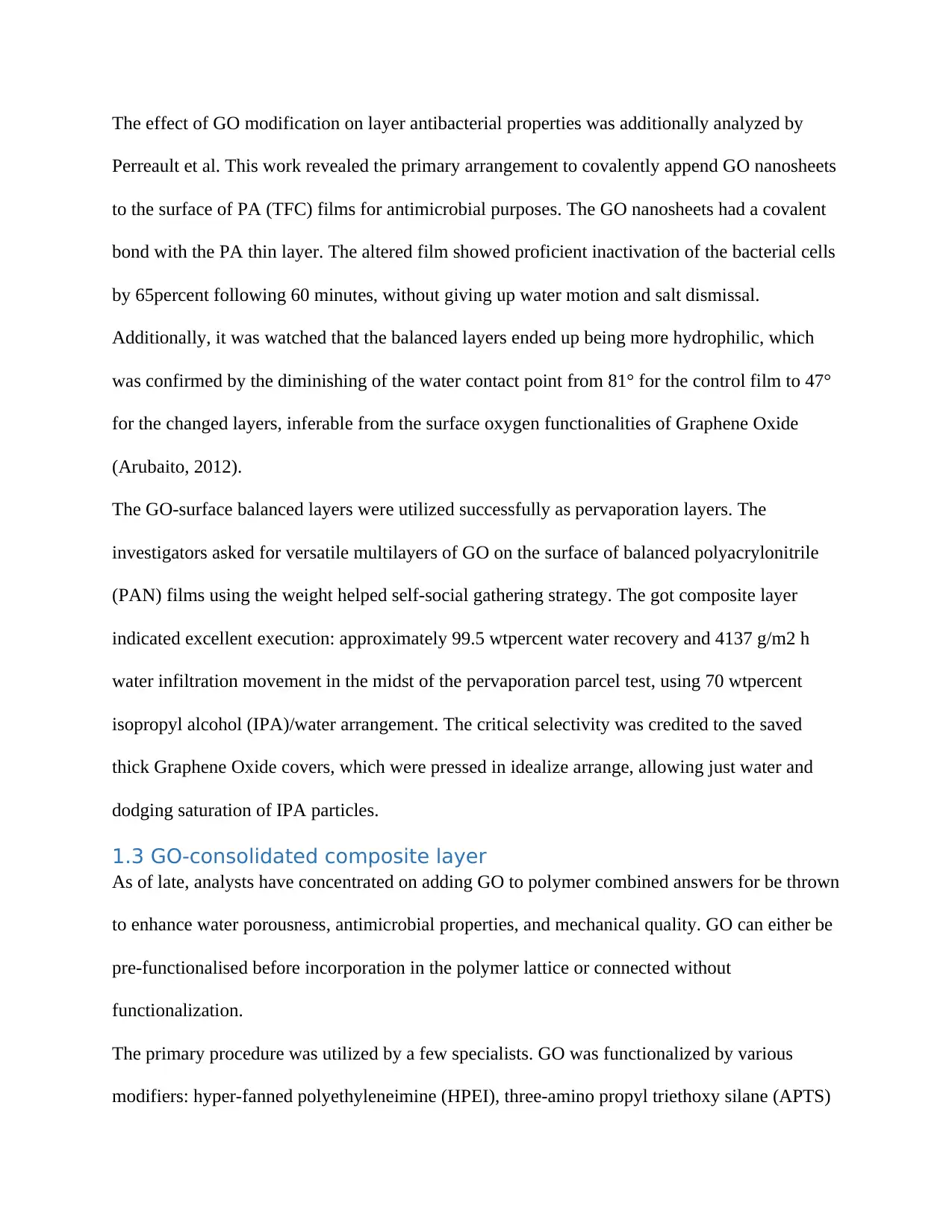
The effect of GO modification on layer antibacterial properties was additionally analyzed by
Perreault et al. This work revealed the primary arrangement to covalently append GO nanosheets
to the surface of PA (TFC) films for antimicrobial purposes. The GO nanosheets had a covalent
bond with the PA thin layer. The altered film showed proficient inactivation of the bacterial cells
by 65percent following 60 minutes, without giving up water motion and salt dismissal.
Additionally, it was watched that the balanced layers ended up being more hydrophilic, which
was confirmed by the diminishing of the water contact point from 81° for the control film to 47°
for the changed layers, inferable from the surface oxygen functionalities of Graphene Oxide
(Arubaito, 2012).
The GO-surface balanced layers were utilized successfully as pervaporation layers. The
investigators asked for versatile multilayers of GO on the surface of balanced polyacrylonitrile
(PAN) films using the weight helped self-social gathering strategy. The got composite layer
indicated excellent execution: approximately 99.5 wtpercent water recovery and 4137 g/m2 h
water infiltration movement in the midst of the pervaporation parcel test, using 70 wtpercent
isopropyl alcohol (IPA)/water arrangement. The critical selectivity was credited to the saved
thick Graphene Oxide covers, which were pressed in idealize arrange, allowing just water and
dodging saturation of IPA particles.
1.3 GO-consolidated composite layer
As of late, analysts have concentrated on adding GO to polymer combined answers for be thrown
to enhance water porousness, antimicrobial properties, and mechanical quality. GO can either be
pre-functionalised before incorporation in the polymer lattice or connected without
functionalization.
The primary procedure was utilized by a few specialists. GO was functionalized by various
modifiers: hyper-fanned polyethyleneimine (HPEI), three-amino propyl triethoxy silane (APTS)
Perreault et al. This work revealed the primary arrangement to covalently append GO nanosheets
to the surface of PA (TFC) films for antimicrobial purposes. The GO nanosheets had a covalent
bond with the PA thin layer. The altered film showed proficient inactivation of the bacterial cells
by 65percent following 60 minutes, without giving up water motion and salt dismissal.
Additionally, it was watched that the balanced layers ended up being more hydrophilic, which
was confirmed by the diminishing of the water contact point from 81° for the control film to 47°
for the changed layers, inferable from the surface oxygen functionalities of Graphene Oxide
(Arubaito, 2012).
The GO-surface balanced layers were utilized successfully as pervaporation layers. The
investigators asked for versatile multilayers of GO on the surface of balanced polyacrylonitrile
(PAN) films using the weight helped self-social gathering strategy. The got composite layer
indicated excellent execution: approximately 99.5 wtpercent water recovery and 4137 g/m2 h
water infiltration movement in the midst of the pervaporation parcel test, using 70 wtpercent
isopropyl alcohol (IPA)/water arrangement. The critical selectivity was credited to the saved
thick Graphene Oxide covers, which were pressed in idealize arrange, allowing just water and
dodging saturation of IPA particles.
1.3 GO-consolidated composite layer
As of late, analysts have concentrated on adding GO to polymer combined answers for be thrown
to enhance water porousness, antimicrobial properties, and mechanical quality. GO can either be
pre-functionalised before incorporation in the polymer lattice or connected without
functionalization.
The primary procedure was utilized by a few specialists. GO was functionalized by various
modifiers: hyper-fanned polyethyleneimine (HPEI), three-amino propyl triethoxy silane (APTS)
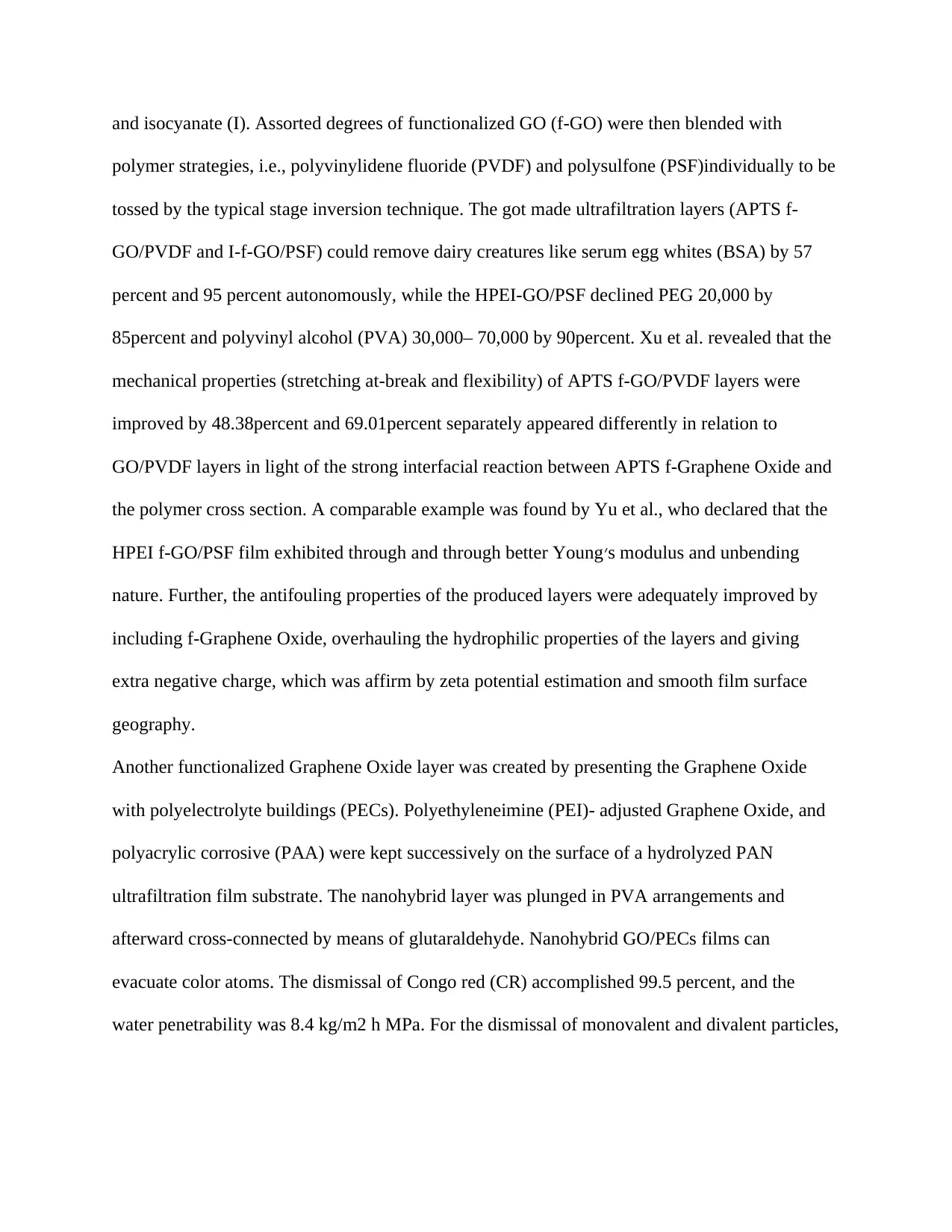
and isocyanate (I). Assorted degrees of functionalized GO (f-GO) were then blended with
polymer strategies, i.e., polyvinylidene fluoride (PVDF) and polysulfone (PSF)individually to be
tossed by the typical stage inversion technique. The got made ultrafiltration layers (APTS f-
GO/PVDF and I-f-GO/PSF) could remove dairy creatures like serum egg whites (BSA) by 57
percent and 95 percent autonomously, while the HPEI-GO/PSF declined PEG 20,000 by
85percent and polyvinyl alcohol (PVA) 30,000– 70,000 by 90percent. Xu et al. revealed that the
mechanical properties (stretching at-break and flexibility) of APTS f-GO/PVDF layers were
improved by 48.38percent and 69.01percent separately appeared differently in relation to
GO/PVDF layers in light of the strong interfacial reaction between APTS f-Graphene Oxide and
the polymer cross section. A comparable example was found by Yu et al., who declared that the
HPEI f-GO/PSF film exhibited through and through better Young׳s modulus and unbending
nature. Further, the antifouling properties of the produced layers were adequately improved by
including f-Graphene Oxide, overhauling the hydrophilic properties of the layers and giving
extra negative charge, which was affirm by zeta potential estimation and smooth film surface
geography.
Another functionalized Graphene Oxide layer was created by presenting the Graphene Oxide
with polyelectrolyte buildings (PECs). Polyethyleneimine (PEI)- adjusted Graphene Oxide, and
polyacrylic corrosive (PAA) were kept successively on the surface of a hydrolyzed PAN
ultrafiltration film substrate. The nanohybrid layer was plunged in PVA arrangements and
afterward cross-connected by means of glutaraldehyde. Nanohybrid GO/PECs films can
evacuate color atoms. The dismissal of Congo red (CR) accomplished 99.5 percent, and the
water penetrability was 8.4 kg/m2 h MPa. For the dismissal of monovalent and divalent particles,
polymer strategies, i.e., polyvinylidene fluoride (PVDF) and polysulfone (PSF)individually to be
tossed by the typical stage inversion technique. The got made ultrafiltration layers (APTS f-
GO/PVDF and I-f-GO/PSF) could remove dairy creatures like serum egg whites (BSA) by 57
percent and 95 percent autonomously, while the HPEI-GO/PSF declined PEG 20,000 by
85percent and polyvinyl alcohol (PVA) 30,000– 70,000 by 90percent. Xu et al. revealed that the
mechanical properties (stretching at-break and flexibility) of APTS f-GO/PVDF layers were
improved by 48.38percent and 69.01percent separately appeared differently in relation to
GO/PVDF layers in light of the strong interfacial reaction between APTS f-Graphene Oxide and
the polymer cross section. A comparable example was found by Yu et al., who declared that the
HPEI f-GO/PSF film exhibited through and through better Young׳s modulus and unbending
nature. Further, the antifouling properties of the produced layers were adequately improved by
including f-Graphene Oxide, overhauling the hydrophilic properties of the layers and giving
extra negative charge, which was affirm by zeta potential estimation and smooth film surface
geography.
Another functionalized Graphene Oxide layer was created by presenting the Graphene Oxide
with polyelectrolyte buildings (PECs). Polyethyleneimine (PEI)- adjusted Graphene Oxide, and
polyacrylic corrosive (PAA) were kept successively on the surface of a hydrolyzed PAN
ultrafiltration film substrate. The nanohybrid layer was plunged in PVA arrangements and
afterward cross-connected by means of glutaraldehyde. Nanohybrid GO/PECs films can
evacuate color atoms. The dismissal of Congo red (CR) accomplished 99.5 percent, and the
water penetrability was 8.4 kg/m2 h MPa. For the dismissal of monovalent and divalent particles,
⊘ This is a preview!⊘
Do you want full access?
Subscribe today to unlock all pages.

Trusted by 1+ million students worldwide
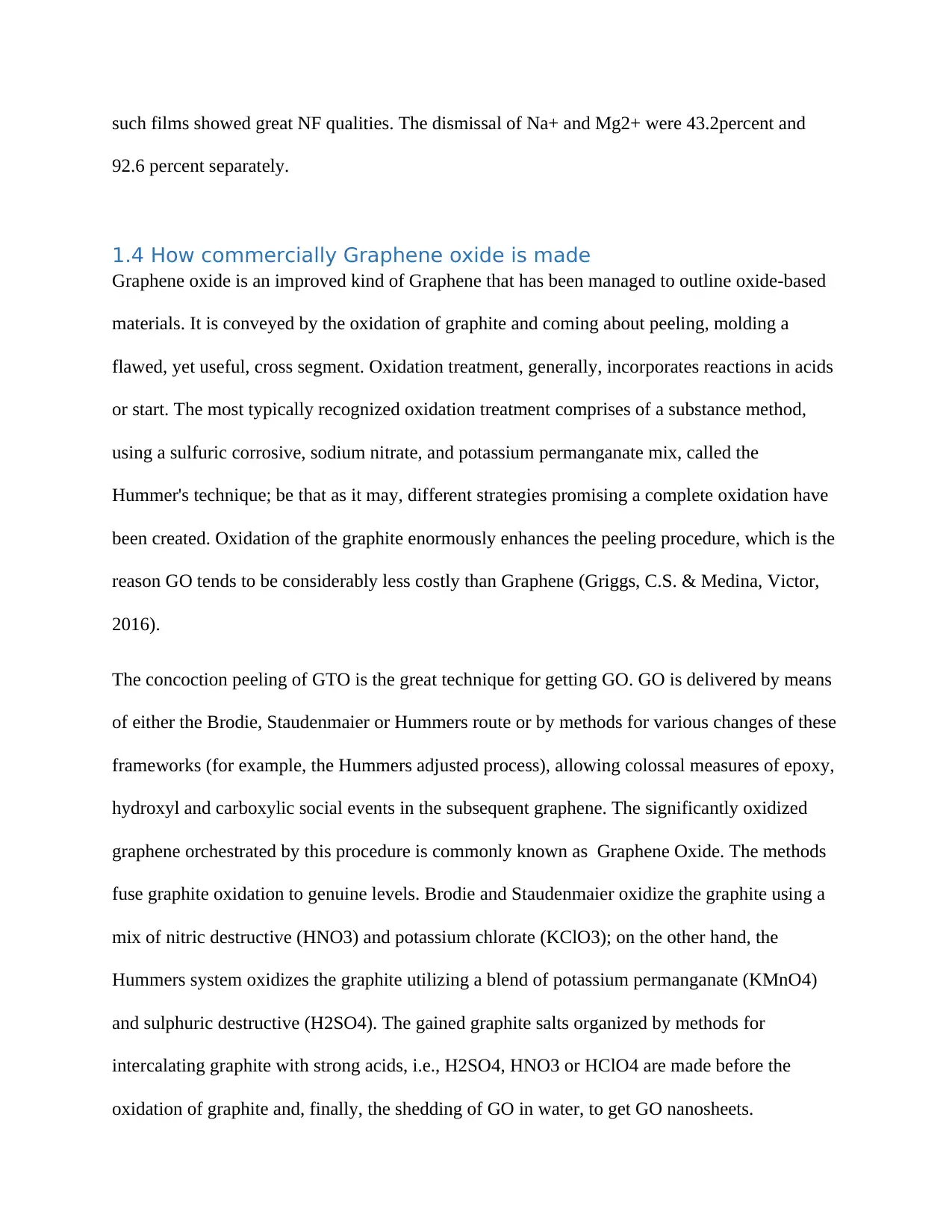
such films showed great NF qualities. The dismissal of Na+ and Mg2+ were 43.2percent and
92.6 percent separately.
1.4 How commercially Graphene oxide is made
Graphene oxide is an improved kind of Graphene that has been managed to outline oxide-based
materials. It is conveyed by the oxidation of graphite and coming about peeling, molding a
flawed, yet useful, cross segment. Oxidation treatment, generally, incorporates reactions in acids
or start. The most typically recognized oxidation treatment comprises of a substance method,
using a sulfuric corrosive, sodium nitrate, and potassium permanganate mix, called the
Hummer's technique; be that as it may, different strategies promising a complete oxidation have
been created. Oxidation of the graphite enormously enhances the peeling procedure, which is the
reason GO tends to be considerably less costly than Graphene (Griggs, C.S. & Medina, Victor,
2016).
The concoction peeling of GTO is the great technique for getting GO. GO is delivered by means
of either the Brodie, Staudenmaier or Hummers route or by methods for various changes of these
frameworks (for example, the Hummers adjusted process), allowing colossal measures of epoxy,
hydroxyl and carboxylic social events in the subsequent graphene. The significantly oxidized
graphene orchestrated by this procedure is commonly known as Graphene Oxide. The methods
fuse graphite oxidation to genuine levels. Brodie and Staudenmaier oxidize the graphite using a
mix of nitric destructive (HNO3) and potassium chlorate (KClO3); on the other hand, the
Hummers system oxidizes the graphite utilizing a blend of potassium permanganate (KMnO4)
and sulphuric destructive (H2SO4). The gained graphite salts organized by methods for
intercalating graphite with strong acids, i.e., H2SO4, HNO3 or HClO4 are made before the
oxidation of graphite and, finally, the shedding of GO in water, to get GO nanosheets.
92.6 percent separately.
1.4 How commercially Graphene oxide is made
Graphene oxide is an improved kind of Graphene that has been managed to outline oxide-based
materials. It is conveyed by the oxidation of graphite and coming about peeling, molding a
flawed, yet useful, cross segment. Oxidation treatment, generally, incorporates reactions in acids
or start. The most typically recognized oxidation treatment comprises of a substance method,
using a sulfuric corrosive, sodium nitrate, and potassium permanganate mix, called the
Hummer's technique; be that as it may, different strategies promising a complete oxidation have
been created. Oxidation of the graphite enormously enhances the peeling procedure, which is the
reason GO tends to be considerably less costly than Graphene (Griggs, C.S. & Medina, Victor,
2016).
The concoction peeling of GTO is the great technique for getting GO. GO is delivered by means
of either the Brodie, Staudenmaier or Hummers route or by methods for various changes of these
frameworks (for example, the Hummers adjusted process), allowing colossal measures of epoxy,
hydroxyl and carboxylic social events in the subsequent graphene. The significantly oxidized
graphene orchestrated by this procedure is commonly known as Graphene Oxide. The methods
fuse graphite oxidation to genuine levels. Brodie and Staudenmaier oxidize the graphite using a
mix of nitric destructive (HNO3) and potassium chlorate (KClO3); on the other hand, the
Hummers system oxidizes the graphite utilizing a blend of potassium permanganate (KMnO4)
and sulphuric destructive (H2SO4). The gained graphite salts organized by methods for
intercalating graphite with strong acids, i.e., H2SO4, HNO3 or HClO4 are made before the
oxidation of graphite and, finally, the shedding of GO in water, to get GO nanosheets.
Paraphrase This Document
Need a fresh take? Get an instant paraphrase of this document with our AI Paraphraser
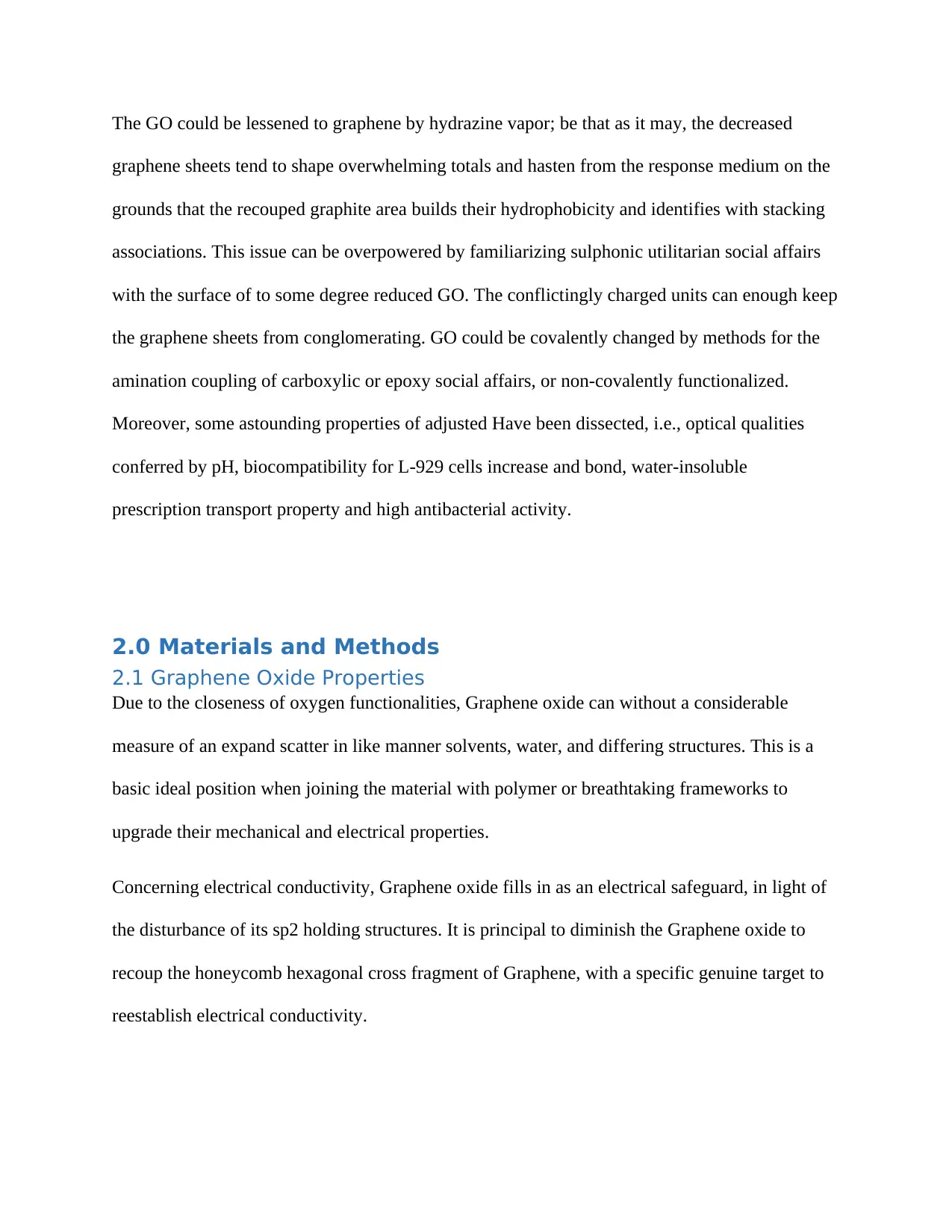
The GO could be lessened to graphene by hydrazine vapor; be that as it may, the decreased
graphene sheets tend to shape overwhelming totals and hasten from the response medium on the
grounds that the recouped graphite area builds their hydrophobicity and identifies with stacking
associations. This issue can be overpowered by familiarizing sulphonic utilitarian social affairs
with the surface of to some degree reduced GO. The conflictingly charged units can enough keep
the graphene sheets from conglomerating. GO could be covalently changed by methods for the
amination coupling of carboxylic or epoxy social affairs, or non-covalently functionalized.
Moreover, some astounding properties of adjusted Have been dissected, i.e., optical qualities
conferred by pH, biocompatibility for L-929 cells increase and bond, water-insoluble
prescription transport property and high antibacterial activity.
2.0 Materials and Methods
2.1 Graphene Oxide Properties
Due to the closeness of oxygen functionalities, Graphene oxide can without a considerable
measure of an expand scatter in like manner solvents, water, and differing structures. This is a
basic ideal position when joining the material with polymer or breathtaking frameworks to
upgrade their mechanical and electrical properties.
Concerning electrical conductivity, Graphene oxide fills in as an electrical safeguard, in light of
the disturbance of its sp2 holding structures. It is principal to diminish the Graphene oxide to
recoup the honeycomb hexagonal cross fragment of Graphene, with a specific genuine target to
reestablish electrical conductivity.
graphene sheets tend to shape overwhelming totals and hasten from the response medium on the
grounds that the recouped graphite area builds their hydrophobicity and identifies with stacking
associations. This issue can be overpowered by familiarizing sulphonic utilitarian social affairs
with the surface of to some degree reduced GO. The conflictingly charged units can enough keep
the graphene sheets from conglomerating. GO could be covalently changed by methods for the
amination coupling of carboxylic or epoxy social affairs, or non-covalently functionalized.
Moreover, some astounding properties of adjusted Have been dissected, i.e., optical qualities
conferred by pH, biocompatibility for L-929 cells increase and bond, water-insoluble
prescription transport property and high antibacterial activity.
2.0 Materials and Methods
2.1 Graphene Oxide Properties
Due to the closeness of oxygen functionalities, Graphene oxide can without a considerable
measure of an expand scatter in like manner solvents, water, and differing structures. This is a
basic ideal position when joining the material with polymer or breathtaking frameworks to
upgrade their mechanical and electrical properties.
Concerning electrical conductivity, Graphene oxide fills in as an electrical safeguard, in light of
the disturbance of its sp2 holding structures. It is principal to diminish the Graphene oxide to
recoup the honeycomb hexagonal cross fragment of Graphene, with a specific genuine target to
reestablish electrical conductivity.
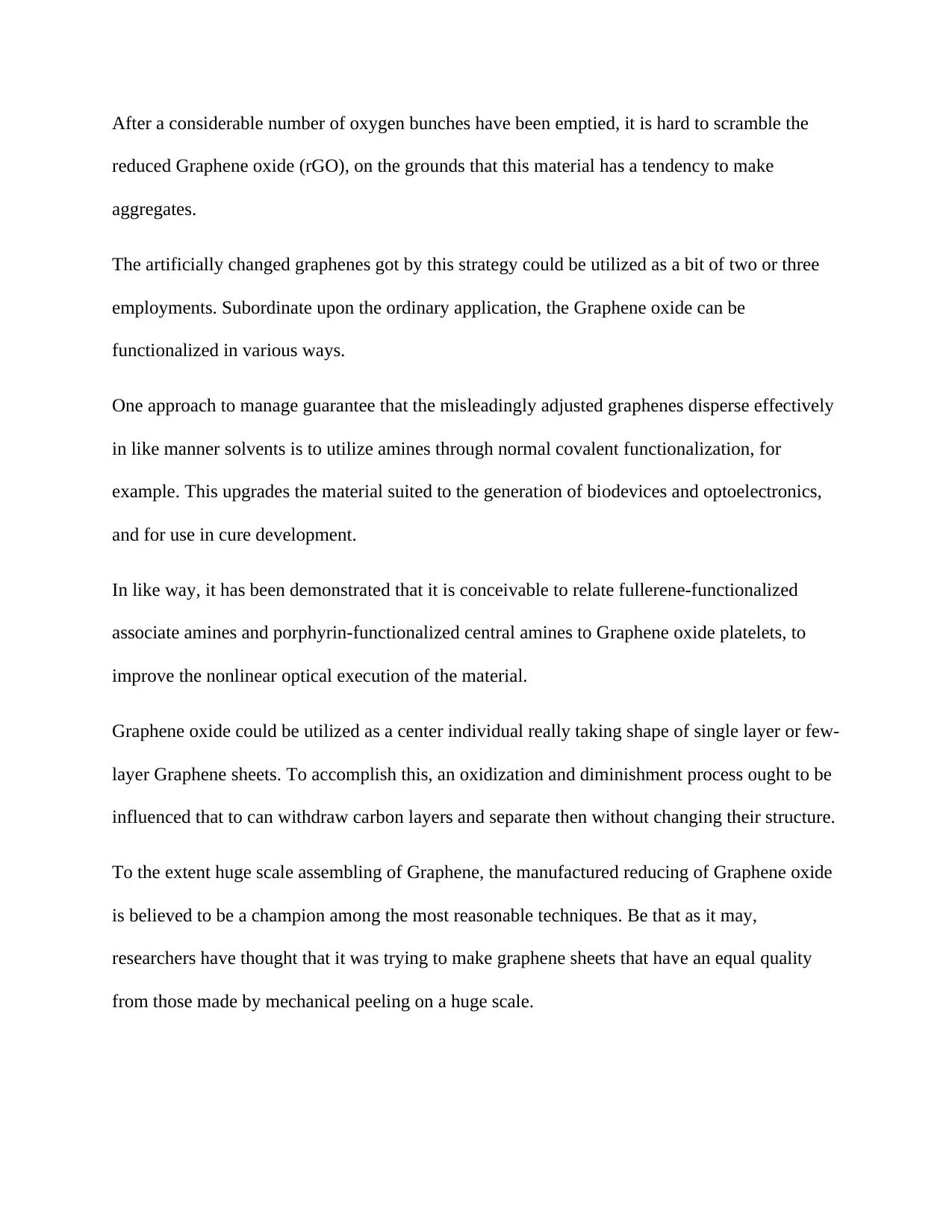
After a considerable number of oxygen bunches have been emptied, it is hard to scramble the
reduced Graphene oxide (rGO), on the grounds that this material has a tendency to make
aggregates.
The artificially changed graphenes got by this strategy could be utilized as a bit of two or three
employments. Subordinate upon the ordinary application, the Graphene oxide can be
functionalized in various ways.
One approach to manage guarantee that the misleadingly adjusted graphenes disperse effectively
in like manner solvents is to utilize amines through normal covalent functionalization, for
example. This upgrades the material suited to the generation of biodevices and optoelectronics,
and for use in cure development.
In like way, it has been demonstrated that it is conceivable to relate fullerene-functionalized
associate amines and porphyrin-functionalized central amines to Graphene oxide platelets, to
improve the nonlinear optical execution of the material.
Graphene oxide could be utilized as a center individual really taking shape of single layer or few-
layer Graphene sheets. To accomplish this, an oxidization and diminishment process ought to be
influenced that to can withdraw carbon layers and separate then without changing their structure.
To the extent huge scale assembling of Graphene, the manufactured reducing of Graphene oxide
is believed to be a champion among the most reasonable techniques. Be that as it may,
researchers have thought that it was trying to make graphene sheets that have an equal quality
from those made by mechanical peeling on a huge scale.
reduced Graphene oxide (rGO), on the grounds that this material has a tendency to make
aggregates.
The artificially changed graphenes got by this strategy could be utilized as a bit of two or three
employments. Subordinate upon the ordinary application, the Graphene oxide can be
functionalized in various ways.
One approach to manage guarantee that the misleadingly adjusted graphenes disperse effectively
in like manner solvents is to utilize amines through normal covalent functionalization, for
example. This upgrades the material suited to the generation of biodevices and optoelectronics,
and for use in cure development.
In like way, it has been demonstrated that it is conceivable to relate fullerene-functionalized
associate amines and porphyrin-functionalized central amines to Graphene oxide platelets, to
improve the nonlinear optical execution of the material.
Graphene oxide could be utilized as a center individual really taking shape of single layer or few-
layer Graphene sheets. To accomplish this, an oxidization and diminishment process ought to be
influenced that to can withdraw carbon layers and separate then without changing their structure.
To the extent huge scale assembling of Graphene, the manufactured reducing of Graphene oxide
is believed to be a champion among the most reasonable techniques. Be that as it may,
researchers have thought that it was trying to make graphene sheets that have an equal quality
from those made by mechanical peeling on a huge scale.
⊘ This is a preview!⊘
Do you want full access?
Subscribe today to unlock all pages.

Trusted by 1+ million students worldwide
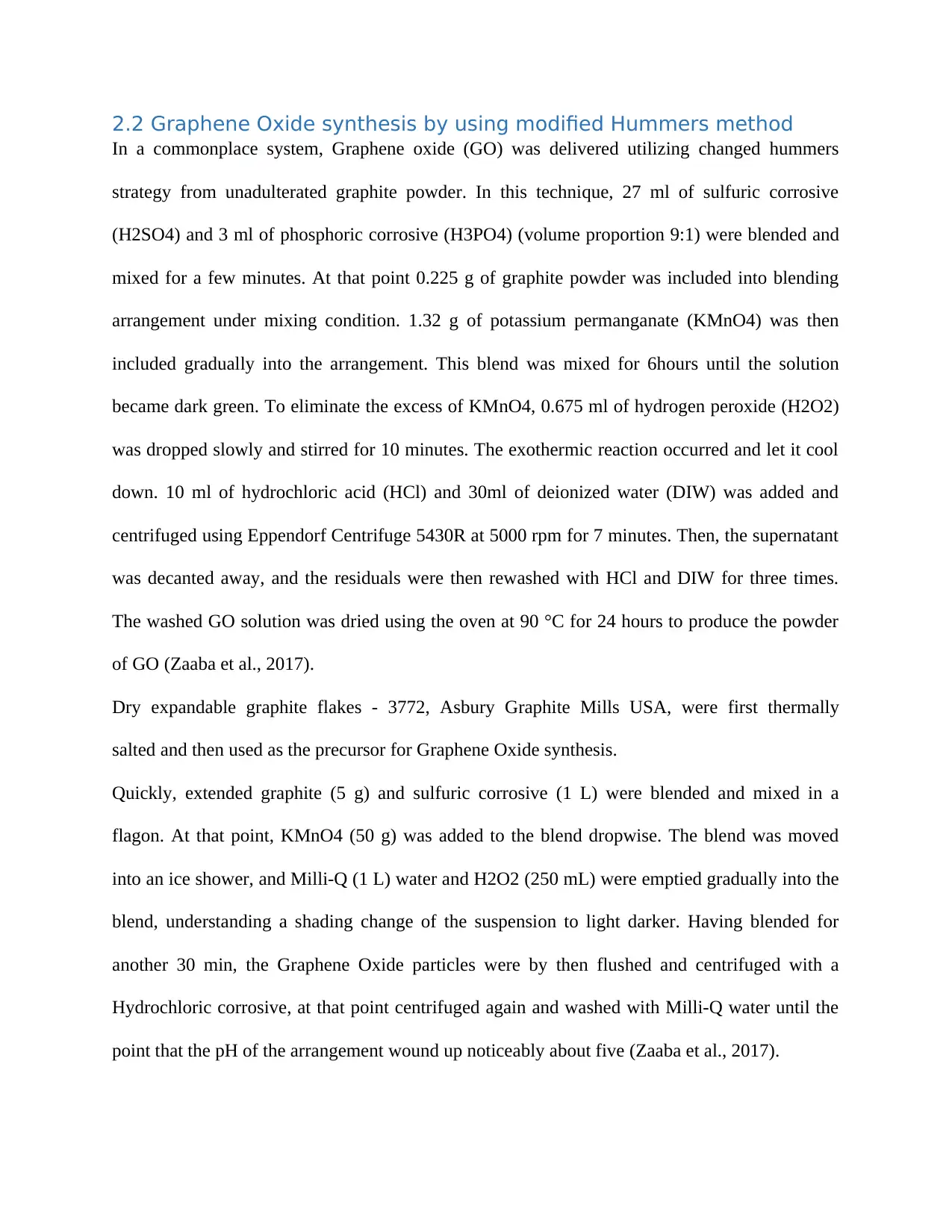
2.2 Graphene Oxide synthesis by using modified Hummers method
In a commonplace system, Graphene oxide (GO) was delivered utilizing changed hummers
strategy from unadulterated graphite powder. In this technique, 27 ml of sulfuric corrosive
(H2SO4) and 3 ml of phosphoric corrosive (H3PO4) (volume proportion 9:1) were blended and
mixed for a few minutes. At that point 0.225 g of graphite powder was included into blending
arrangement under mixing condition. 1.32 g of potassium permanganate (KMnO4) was then
included gradually into the arrangement. This blend was mixed for 6hours until the solution
became dark green. To eliminate the excess of KMnO4, 0.675 ml of hydrogen peroxide (H2O2)
was dropped slowly and stirred for 10 minutes. The exothermic reaction occurred and let it cool
down. 10 ml of hydrochloric acid (HCl) and 30ml of deionized water (DIW) was added and
centrifuged using Eppendorf Centrifuge 5430R at 5000 rpm for 7 minutes. Then, the supernatant
was decanted away, and the residuals were then rewashed with HCl and DIW for three times.
The washed GO solution was dried using the oven at 90 °C for 24 hours to produce the powder
of GO (Zaaba et al., 2017).
Dry expandable graphite flakes - 3772, Asbury Graphite Mills USA, were first thermally
salted and then used as the precursor for Graphene Oxide synthesis.
Quickly, extended graphite (5 g) and sulfuric corrosive (1 L) were blended and mixed in a
flagon. At that point, KMnO4 (50 g) was added to the blend dropwise. The blend was moved
into an ice shower, and Milli-Q (1 L) water and H2O2 (250 mL) were emptied gradually into the
blend, understanding a shading change of the suspension to light darker. Having blended for
another 30 min, the Graphene Oxide particles were by then flushed and centrifuged with a
Hydrochloric corrosive, at that point centrifuged again and washed with Milli-Q water until the
point that the pH of the arrangement wound up noticeably about five (Zaaba et al., 2017).
In a commonplace system, Graphene oxide (GO) was delivered utilizing changed hummers
strategy from unadulterated graphite powder. In this technique, 27 ml of sulfuric corrosive
(H2SO4) and 3 ml of phosphoric corrosive (H3PO4) (volume proportion 9:1) were blended and
mixed for a few minutes. At that point 0.225 g of graphite powder was included into blending
arrangement under mixing condition. 1.32 g of potassium permanganate (KMnO4) was then
included gradually into the arrangement. This blend was mixed for 6hours until the solution
became dark green. To eliminate the excess of KMnO4, 0.675 ml of hydrogen peroxide (H2O2)
was dropped slowly and stirred for 10 minutes. The exothermic reaction occurred and let it cool
down. 10 ml of hydrochloric acid (HCl) and 30ml of deionized water (DIW) was added and
centrifuged using Eppendorf Centrifuge 5430R at 5000 rpm for 7 minutes. Then, the supernatant
was decanted away, and the residuals were then rewashed with HCl and DIW for three times.
The washed GO solution was dried using the oven at 90 °C for 24 hours to produce the powder
of GO (Zaaba et al., 2017).
Dry expandable graphite flakes - 3772, Asbury Graphite Mills USA, were first thermally
salted and then used as the precursor for Graphene Oxide synthesis.
Quickly, extended graphite (5 g) and sulfuric corrosive (1 L) were blended and mixed in a
flagon. At that point, KMnO4 (50 g) was added to the blend dropwise. The blend was moved
into an ice shower, and Milli-Q (1 L) water and H2O2 (250 mL) were emptied gradually into the
blend, understanding a shading change of the suspension to light darker. Having blended for
another 30 min, the Graphene Oxide particles were by then flushed and centrifuged with a
Hydrochloric corrosive, at that point centrifuged again and washed with Milli-Q water until the
point that the pH of the arrangement wound up noticeably about five (Zaaba et al., 2017).
Paraphrase This Document
Need a fresh take? Get an instant paraphrase of this document with our AI Paraphraser
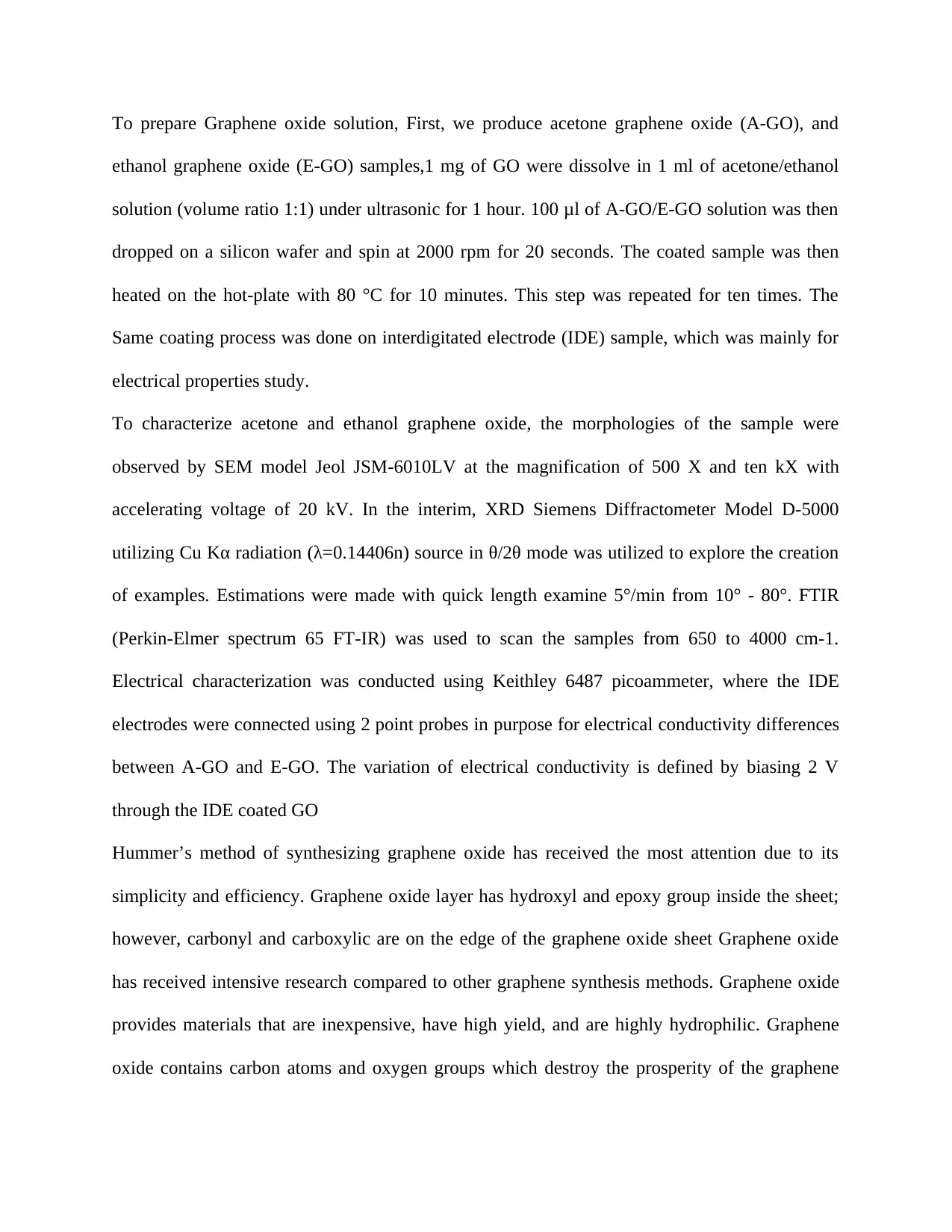
To prepare Graphene oxide solution, First, we produce acetone graphene oxide (A-GO), and
ethanol graphene oxide (E-GO) samples,1 mg of GO were dissolve in 1 ml of acetone/ethanol
solution (volume ratio 1:1) under ultrasonic for 1 hour. 100 μl of A-GO/E-GO solution was then
dropped on a silicon wafer and spin at 2000 rpm for 20 seconds. The coated sample was then
heated on the hot-plate with 80 °C for 10 minutes. This step was repeated for ten times. The
Same coating process was done on interdigitated electrode (IDE) sample, which was mainly for
electrical properties study.
To characterize acetone and ethanol graphene oxide, the morphologies of the sample were
observed by SEM model Jeol JSM-6010LV at the magnification of 500 X and ten kX with
accelerating voltage of 20 kV. In the interim, XRD Siemens Diffractometer Model D-5000
utilizing Cu Kα radiation (λ=0.14406n) source in θ/2θ mode was utilized to explore the creation
of examples. Estimations were made with quick length examine 5°/min from 10° - 80°. FTIR
(Perkin-Elmer spectrum 65 FT-IR) was used to scan the samples from 650 to 4000 cm-1.
Electrical characterization was conducted using Keithley 6487 picoammeter, where the IDE
electrodes were connected using 2 point probes in purpose for electrical conductivity differences
between A-GO and E-GO. The variation of electrical conductivity is defined by biasing 2 V
through the IDE coated GO
Hummer’s method of synthesizing graphene oxide has received the most attention due to its
simplicity and efficiency. Graphene oxide layer has hydroxyl and epoxy group inside the sheet;
however, carbonyl and carboxylic are on the edge of the graphene oxide sheet Graphene oxide
has received intensive research compared to other graphene synthesis methods. Graphene oxide
provides materials that are inexpensive, have high yield, and are highly hydrophilic. Graphene
oxide contains carbon atoms and oxygen groups which destroy the prosperity of the graphene
ethanol graphene oxide (E-GO) samples,1 mg of GO were dissolve in 1 ml of acetone/ethanol
solution (volume ratio 1:1) under ultrasonic for 1 hour. 100 μl of A-GO/E-GO solution was then
dropped on a silicon wafer and spin at 2000 rpm for 20 seconds. The coated sample was then
heated on the hot-plate with 80 °C for 10 minutes. This step was repeated for ten times. The
Same coating process was done on interdigitated electrode (IDE) sample, which was mainly for
electrical properties study.
To characterize acetone and ethanol graphene oxide, the morphologies of the sample were
observed by SEM model Jeol JSM-6010LV at the magnification of 500 X and ten kX with
accelerating voltage of 20 kV. In the interim, XRD Siemens Diffractometer Model D-5000
utilizing Cu Kα radiation (λ=0.14406n) source in θ/2θ mode was utilized to explore the creation
of examples. Estimations were made with quick length examine 5°/min from 10° - 80°. FTIR
(Perkin-Elmer spectrum 65 FT-IR) was used to scan the samples from 650 to 4000 cm-1.
Electrical characterization was conducted using Keithley 6487 picoammeter, where the IDE
electrodes were connected using 2 point probes in purpose for electrical conductivity differences
between A-GO and E-GO. The variation of electrical conductivity is defined by biasing 2 V
through the IDE coated GO
Hummer’s method of synthesizing graphene oxide has received the most attention due to its
simplicity and efficiency. Graphene oxide layer has hydroxyl and epoxy group inside the sheet;
however, carbonyl and carboxylic are on the edge of the graphene oxide sheet Graphene oxide
has received intensive research compared to other graphene synthesis methods. Graphene oxide
provides materials that are inexpensive, have high yield, and are highly hydrophilic. Graphene
oxide contains carbon atoms and oxygen groups which destroy the prosperity of the graphene
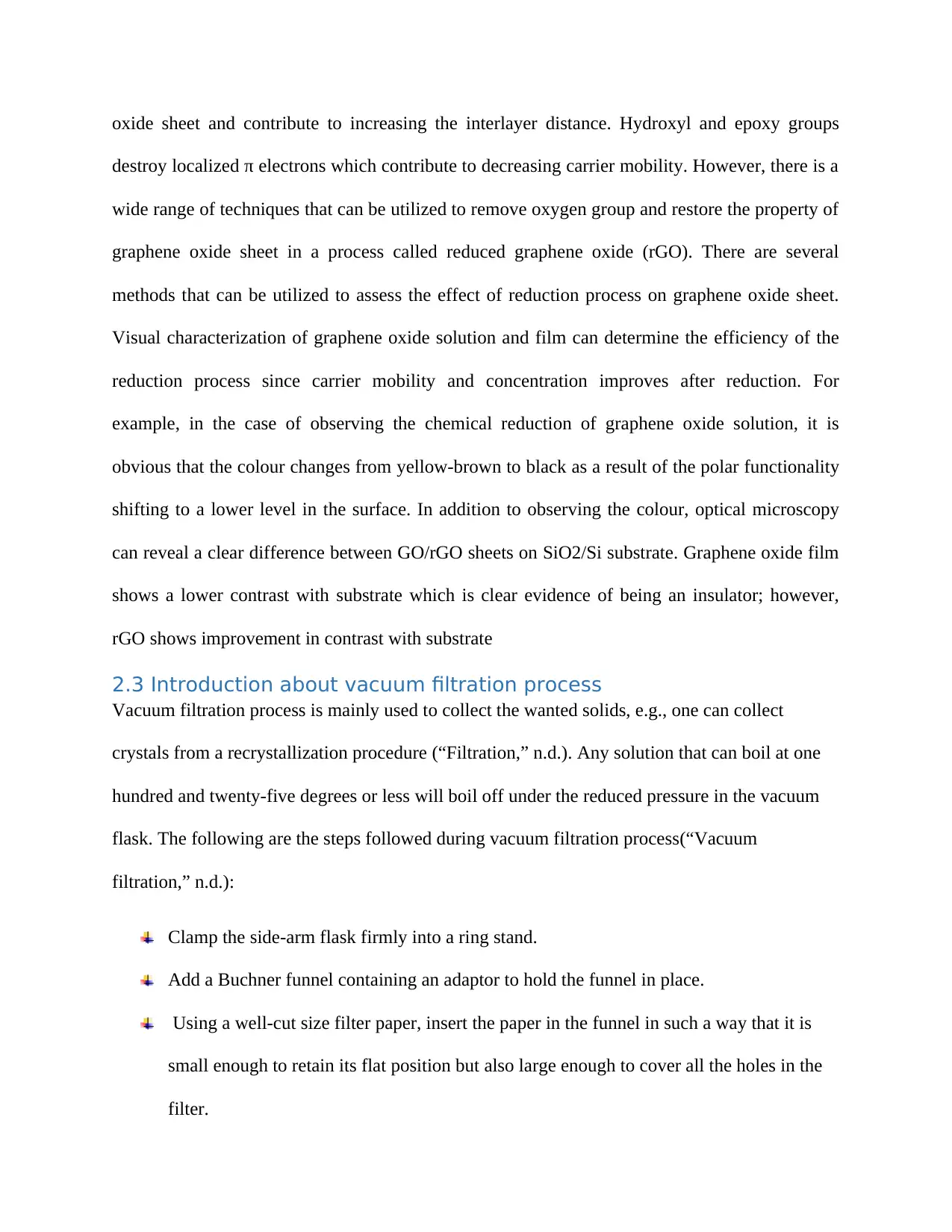
oxide sheet and contribute to increasing the interlayer distance. Hydroxyl and epoxy groups
destroy localized π electrons which contribute to decreasing carrier mobility. However, there is a
wide range of techniques that can be utilized to remove oxygen group and restore the property of
graphene oxide sheet in a process called reduced graphene oxide (rGO). There are several
methods that can be utilized to assess the effect of reduction process on graphene oxide sheet.
Visual characterization of graphene oxide solution and film can determine the efficiency of the
reduction process since carrier mobility and concentration improves after reduction. For
example, in the case of observing the chemical reduction of graphene oxide solution, it is
obvious that the colour changes from yellow-brown to black as a result of the polar functionality
shifting to a lower level in the surface. In addition to observing the colour, optical microscopy
can reveal a clear difference between GO/rGO sheets on SiO2/Si substrate. Graphene oxide film
shows a lower contrast with substrate which is clear evidence of being an insulator; however,
rGO shows improvement in contrast with substrate
2.3 Introduction about vacuum filtration process
Vacuum filtration process is mainly used to collect the wanted solids, e.g., one can collect
crystals from a recrystallization procedure (“Filtration,” n.d.). Any solution that can boil at one
hundred and twenty-five degrees or less will boil off under the reduced pressure in the vacuum
flask. The following are the steps followed during vacuum filtration process(“Vacuum
filtration,” n.d.):
Clamp the side-arm flask firmly into a ring stand.
Add a Buchner funnel containing an adaptor to hold the funnel in place.
Using a well-cut size filter paper, insert the paper in the funnel in such a way that it is
small enough to retain its flat position but also large enough to cover all the holes in the
filter.
destroy localized π electrons which contribute to decreasing carrier mobility. However, there is a
wide range of techniques that can be utilized to remove oxygen group and restore the property of
graphene oxide sheet in a process called reduced graphene oxide (rGO). There are several
methods that can be utilized to assess the effect of reduction process on graphene oxide sheet.
Visual characterization of graphene oxide solution and film can determine the efficiency of the
reduction process since carrier mobility and concentration improves after reduction. For
example, in the case of observing the chemical reduction of graphene oxide solution, it is
obvious that the colour changes from yellow-brown to black as a result of the polar functionality
shifting to a lower level in the surface. In addition to observing the colour, optical microscopy
can reveal a clear difference between GO/rGO sheets on SiO2/Si substrate. Graphene oxide film
shows a lower contrast with substrate which is clear evidence of being an insulator; however,
rGO shows improvement in contrast with substrate
2.3 Introduction about vacuum filtration process
Vacuum filtration process is mainly used to collect the wanted solids, e.g., one can collect
crystals from a recrystallization procedure (“Filtration,” n.d.). Any solution that can boil at one
hundred and twenty-five degrees or less will boil off under the reduced pressure in the vacuum
flask. The following are the steps followed during vacuum filtration process(“Vacuum
filtration,” n.d.):
Clamp the side-arm flask firmly into a ring stand.
Add a Buchner funnel containing an adaptor to hold the funnel in place.
Using a well-cut size filter paper, insert the paper in the funnel in such a way that it is
small enough to retain its flat position but also large enough to cover all the holes in the
filter.
⊘ This is a preview!⊘
Do you want full access?
Subscribe today to unlock all pages.

Trusted by 1+ million students worldwide
1 out of 36
Your All-in-One AI-Powered Toolkit for Academic Success.
+13062052269
info@desklib.com
Available 24*7 on WhatsApp / Email
![[object Object]](/_next/static/media/star-bottom.7253800d.svg)
Unlock your academic potential
Copyright © 2020–2025 A2Z Services. All Rights Reserved. Developed and managed by ZUCOL.